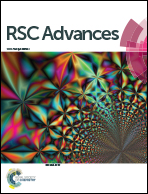Nanostructured Bi(1−x)Gd(x)FeO3 – a multiferroic photocatalyst on its sunlight driven photocatalytic activity
Abstract
The photocatalytic activity of sol–gel synthesized nanostructured Bi1−xGdxFeO3 (x = 0, 0.05, 0.1, 0.15) particles on the degradation of methylene blue (MB) was demonstrated for the first time under sunlight. The X-ray diffraction (XRD) studies showed that the substitution induced structural changes in 10 and 15% Gd substituted BiFeO3 (BFO). The morphology analysis, by field emission scanning (FESEM) and high resolution transmission electron microscopy (HRTEM), presented the composition driven particle size reduction and morphology changes in BFO from irregular to spherical shape. The band gap estimation by UV-visible diffuse reflectance spectroscopy revealed that increasing concentration of Gd significantly reduced the band gap of BFO from 2.38 eV to 2.29 eV. An anomalous magnetic enhancement was observed in Bi0.90Gd0.10FeO3 nanoparticles due to the manifestation of antiferromagnetic (AFM) core–ferromagnetic (FM) shell-like structure, revealed by its M–H hysteresis curve. An increasing trend in the photocatalytic activity of BFO was observed with increasing concentration of Gd. In this case, enhanced photocatalytic activity observed in Bi0.85Gd0.15FeO3 could be due to its increased ferroelectric domains that drive the charge carriers to the catalyst surface–dye interface, leading to more effective degradation of the dye. Conversely, an anomalous photocatalytic activity was observed in Bi0.90Gd0.10FeO3 that should be attributed to its AFM–FM core–shell-like structure.


 Please wait while we load your content...
Please wait while we load your content...